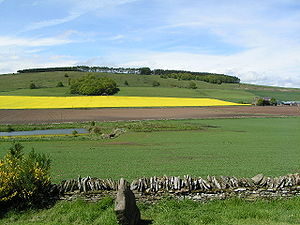Dunnichen Hill
| Dunnichen Hill | |
| Angus | |
|---|---|

| |
| Summit: | 764 feet NO509497 56°38’12"N, 2°48’7"W |
Dunnichen Hill stands to the north of the village of Dunnichen in Angus: the village named from the hill. The name "Dunnichen" is from the Gaelic language and means "Nechtan's Hill", presumably after Nechtan King of the Picts.
This is an ancient place, for the hill is crowned with earthworks from a hill fort of uncertain age. A class II Pictish standing stone was unearthed at East Mains of Dunnichen.[1][2] This is now located at the Meffan Institute at Forfar.[3]
As well as hillforts on the hill and there is an ancient barrow, a burial mound.
Battle of Nechtansmere
The hill, or the fields beneath it, are widely believed by historians to mark a cataclysmic battle in the year 685; in that year according to Bede's Ecclesiastical History of the English People, King Ecgfrith of Northumbria was slain in battle with the Picts at 'Nechtansmere' ("Nechtan's Lake"), and this battle, Bede reports, broke Northumbria's lordship over the Picts. He adds that it was divine retribution for Ecgfrith's raid on Ireland. Philologists propose that 'Nechtansmere' was at or near Dunnichen.
An early local tradition, related by Headrick in the Second Statistical Account, claimed that the site was the location of the Battle of Camlann, where King Arthur fought Mordred.[1]
A confused tradition prevails of a great battle having been fought on the East Mains of Dunnichen, between Lothus, King of the Picts, or his son Modred, and Arthur King of the Britons, in which that hero of romance was slain. Buchanan, no doubt, places the scene of that battle upon the banks of the Humber, in England. But it is probable that some battle had been fought here[...][1]
In 1810, antiquarian George Chalmers identified that site as the probable location of the Battle of Dun Nechtain in 20 May 685, where the Picts, led by King Bridei Mac Bili conclusively defeated a Northumbrian army, led by King Ecgfrith, resulting in Ecgfrith's death.[4] For many years, Chalmer's theory has been accepted by historians,[5] but this has recently been called into some doubt.[6]
References
- ↑ 1.0 1.1 1.2 Headrick, James (1845), "Parish of Dunnichen", New Statistical Account of Scotland, http://books.google.com/?id=PqACAAAAMAAJ&pg=PA142, retrieved July 27, 2010
- ↑ Jervise, Andrew (1857), "Notices descriptive of the localities of certain sculptured stone monuments in Forfarshire, &c (Part i.)", Proceedings of the Society of Antiquaries of Scotland 2: 187–201, http://ads.ahds.ac.uk/catalogue/adsdata/PSAS_2002/pdf/vol_002/2_187_201.pdf, retrieved July 27, 2010
- ↑ "Pictish Carved Stone Collection", Meffan Museum and Art Gallery, http://www.angus.gov.uk/history/museums/meffan/pictish.htm, retrieved July 29, 2009
- ↑ Chalmers, George (1887), Caledonia: or a historical and topographical account of North Britain, from the most ancient to the present times with a dictionary of places chorographical and philological, 1 (new ed.), Paisley: Alex. Gardner, http://www.archive.org/stream/caledoniaorhisto01chal/caledoniaorhisto01chal_djvu.txt
- ↑ see for example:
Fraser, James E. (2006), The Pictish Conquest: The Battle Of Dunnichen 685 and the Birth of Scotland, Stroud, Glos.: Tempus - ↑ Woolf, Alex (2006), "Dun Nechtain, Fortriu and the Geography of the Picts", The Scottish Historical Review 85 (2): 182–201, doi:10.1353/shr.2007.0029.